“ The road took us higher and higher and seemed to have no end. We were climbing to the summit through a dense forest of trees. A fine drizzle seemed to hang in the air. As we climbed, the roar of the waterfalls, like white tassels on a green dress, rushing down the slopes to mingle with the river in the valley below grew fainter and fainter. Just when my leg muscles were about to give out, we spotted the monastery from an opening in the foliage. Not a monastery but an apparition reposing in stone, a rock utopia. When I reached it, the winged horses of my imagination suddenly fled to the sky’s grey expanse. Embedded in the belly of the rock, the ruins of the monastery looked out over a deep chasm. From between the rocks water dripped into the monastery from above, while people of diverse religions, murmuring prayers, drank from its sacred spring. A portion of the frescoes had been cut out like pieces of pie years ago and smuggled off to who knows where.”
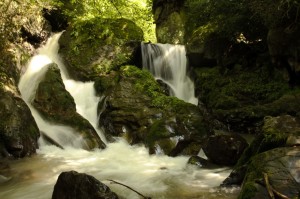
Galiana river (Galyan deresi) from Trabzon
Photo © Özhan Öztürk
So reads a diary entry I made about the Sumela Monastery at Maçka twenty-five years ago. Although the earliest parts of Sumela, dubbed the ‘Monastery in the Clouds’ by Tarsicio Succi da Verica, are said to have been built by the Byzantine Emperor Justinian, nothing is known for certain. But in 1340 the Emperor Alexius Comnenus staged his coronation ceremony here in this structure, perched on the rocks like a
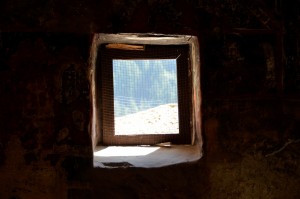
window of a room (Παναγία Σουμελά, Ματσούκα)
Photo © Özhan Öztürk
crown; indeed, he even observed the great solar eclipse from its vantage point. Sumela’s past is veiled in mystery, which makes it as intriguing as its remote setting. Legends are rife, from the smuggling to Athens of the monastery’s icon of the Virgin Mary, believed to have been painted by the Gospel writer Luke himself, to the fate of the golden candelabra bestowed on the monastery by Sultan Selim I following his defeat of Shah Ismail and the Safavid Persians in 1514. And as if this weren’t enough, anyone asked to name the ten most popular touristic sites in Turkey would surely list Sumela among them. There are ruins of two other famous monasteries at Maçka: the Vazelon in the village of Kiremitli and the Kuştul in the village of Şimşirli. The road to Kuştul especially, with its rippling streams and wooden bridges, is an added boon for hikers and nature-lovers.
A GREEN JEWEL
The fame of the Sumela Monastery surpasses that of Maçka, 30 km from Trabzon, even though Maçka is one of the green jewels not just of
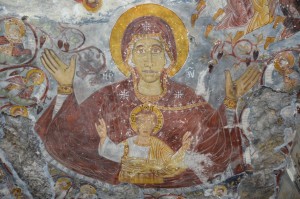
frescoes from sumela monastery (Παναγία Σουμελά, Ματσούκα)
Photo © Özhan Öztürk
the Eastern Black Sea (in Turkish ‘Dogu Karadeniz) but of Turkey in general. Nature has so blessed this area that when you are plunged into mist on the road to Maçka you will sigh, saying “Who knows how much beauty there is along this road that I can’t even see?” But don’t blame the mist, for it is a friend of the forests and plateaus.
I recall what the village headman said as we dipped our bread in clotted cream made from fresh milk in the 1600 meter-high Şomla Highlands:
“Snow starts to fall here towards harvest time. And the flakes, driven by the wind, hit the ground like little white nails. I never tire
frescoes from sumela monastery (Παναγία Σουμελά, Ματσούκα)
Photo © Özhan Öztürkof gazing at the landscape through my window. And another thing: the trees in that forest over there make such a roar in the wind that people come here just to hear it.”
I chime in that people come to Maçka for a thousand and one different sounds. The patter of the rain, for example. The wild strains of the kemenche, or the splash of buttermilk being poured into a glass. There are even those who come to hear a slab of thick clotted cream sizzling over a fire, or the friendly greetings of the natives along the roadside.
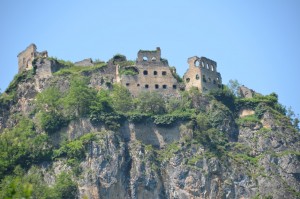
Kuştul Monastery (Ιερά Μονή του Αγίου Γεωργίου Περιστερεώτα, Ματσούκα)
Photo © Özhan Öztürk
While a young man cuts wood, his sister drives the cows to pasture. Dewdrops sparkle on the leaves like diamonds in the sun, and the brilliant golden hue of the yellow rhododendrons catches your eye.
Approaching the windows of the highland houses above their pink flowers, the mist peeks in. And why not? What’s to stop it, you say? It is seeking a creature called the ‘tea kettle’ that is also said to emit ‘mist’ from its long, curving spout, even to sing a lively song when a fire burns under it! And when the mist finds this creature, it will surround it on all sides and try to ferret out whether it’s a distant relative or not.
JULY, THE FESTIVE MONTH
The plateaus are gay with buttercups, crocuses, cornflowers, Pontic rhododendrons, orchids, fuchsias, foxglove and cowslips, whose names sometimes vary even from one highland to another. Lapazan, Kulin Dağı, Maura, Kiraz and Çakırgöl are the most famous of the highlands, together with Şolma and Lişer. Carpeted with crocuses in May, they are most festive in July when the strains of the kemenche and the voices of the ‘horon’ dancers resound through the valleys.
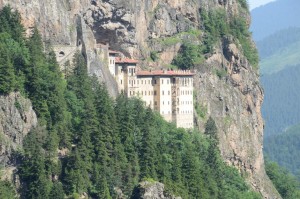
Sümela monastery is a Greek Orthodox monastery dedicated to the Virgin Mary at Trabzon Black Sea region of Turkey
Photo © Özhan Öztürk
“The green plateaus where sheep, cows and children gather at the start of summer are known as ‘yayla’ in the vernacular of our region,” explains writer Ismet Zeki Eyüboğlu in his book, ‘Maçka’. “As soon as the heat begins to set in, the sheep are dyed, the cows and unweaned calves are decked with little bells and the nanny-goats and billy-goats with big bells, and then all hit the road for the highlands. Young men and women don red and green, while the oldsters rub themselves with henna.”
Head for the Zigana range, enjoy fresh milk pudding at Hamsiköy, or breathe in the fresh air on the upland byways. It’s your choice at Maçka. But be sure to bend softly over the purple rhododendrons the locals call ‘gomar’ and take a closer look at the drops left on their leaves by the rain that got to the ‘yayla’ before you. If you look carefully, you will see the mountains, forests and highland houses reflected in their aqueous globes and you will marvel at how nature has distilled the whole world into a single drop at Maçka! As you do so, the strains of a folk tune will reach your ears, sung by a girl hanging up laundry in her garden:
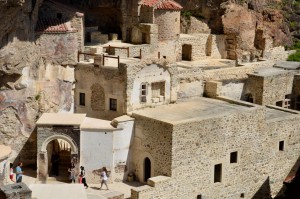
The Sumela Monastery (Greek: Μονή Παναγίας Σουμελά, Moní Panagías Soumelá; Turkish: Sümela Manastırı)
(Παναγία Σουμελά, Ματσούκα)
“Made of stone are Maçka’s roads / Chagrin d’amour is a heavy load / You’re the blossom, I the leaf / On which branch did we flower?” And I shall recall a poem called ‘Window’ by Sunay Akın, a poet who was born in Maçka, in his father, tax collector Şükrü Efendi’s mansion, in the village of Konaklar overlooking the Galyan valley and who spent the halcyon days of his childhood in the garden of the same house. I close with a few of his lines: “Evenings the new bride / leaves her door open / so the aroma of the dishes she is cooking / will waft through the neighborhood.”


